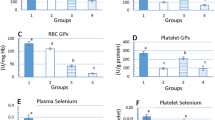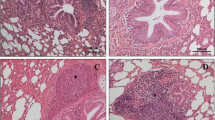Abstract
Unlike in human medicine, information on the platelet selenium (Se) concentration and glutathione peroxidase (GPx) activity, as potential biomarkers of Se status, is lacking in the field of veterinary medicine. The aims of this study were to compare the effects of sodium selenite (SeS) and Se nanoparticles (SeN) on platelet Se indices, and compare the results with those of conventional indices of Se status in sheep. Eighteen lambs with marginal Se status were assigned to a control (CON) group and two Se-treated groups administered either a single dose of Se at 0.055 mg/kg BW subcutaneously as SeS or SeN. The Se concentration and GPx activity in plasma, erythrocytes, whole blood, and platelets were assessed at 14 time points during 90 days. In Se-treated groups, Se concentrations and GPx activity increased significantly in plasma, whole blood, erythrocytes, and platelets. However, the responses in SeS group often started and peaked earlier and, in almost all time points, were more pronounced than the SeN group (P < 0.001), indicating that SeS compared to SeN was more biopotent in raising Se biomarkers. Se indices in platelets started and peaked later than those of short-term (in plasma) and earlier than those of long-term indices (in erythrocytes) indicating that platelet indices can serve as intermediate-term biomarkers of Se status. In conclusion, platelet indices of Se are promising proxy for currently used indices of Se status in sheep, regardless of Se source.






Similar content being viewed by others
References
Abuelo A, Alves-Nores V, Hernandez J, Muiño R, Benedito JL, Castillo C (2016) Effect of parenteral antioxidant supplementation during the dry period on postpartum glucose tolerance in dairy cows. J Vet Intern Med 30:892–898
Alfthan G, Aro A, Arvilommi H et al (1991) Selenium metabolism and platelet glutathione peroxidase activity in healthy Finnish men : effect of selenium yeast, selenite and selenate. Am J Clin Nutr 53:12–125
Ashton K, Hooper L, Harvey LJ, Hurst R, Casgrain A, Fairweather-Tait SJ (2009) Methods of assessment of selenium status in humans: a systematic review. Am J Clin Nutr 89:2025S–2039S
Boostani A, Sadeghi AA, Mousavi S et al (2015) Effects of organic, inorganic, and nano-Se on growth performance, antioxidant capacity, cellular and humoral immune responses in broiler chickens exposed to oxidative stress. Livest Sci 178:330–336
Bradford MM (1976) A rapid and sensitive method for the quantitation of microgram quantities of protein utilizing the principle of protein-dye binding. Anal Biochem 72:248–254
Burk RF, Hill KE (2015) Regulation of selenium metabolism and transport. Annu Rev Nutr 35:109–134
Burk RF, Lane JM, Lawrence RA et al (1981) Effect of selenium deficiency on liver and blood glutathione peroxidase activity in guinea pigs. J Nutr 11:690–693
Constable P, Hinchcliff KW, Done S et al (2017) Veterinary medicine: a textbook of the diseases of cattle, horses, sheep, pigs and goats. Saunders Ltd
Dalir-Naghadeh B, Bahrami Y, Asri Rezaei S et al (2015) Platelet indices of selenium status in healthy and selenium-deficient sheep: a comparison with selenium indices in plasma, whole blood, and red blood cells. Biol Trace Elem Res 168:74–81
Fu C, Liu T, Li L, Liu H, Chen D, Tang F (2013) The absorption, distribution, excretion and toxicity of mesoporous silica nanoparticles in mice following different exposure routes. Biomaterials 34:2565–2575
Gao X, Sun Y (2013) Selenium nanoparticles with improved biological effects. US Patent
Herdt TH, Hoff B (2011) The use of blood analysis to evaluate trace mineral status in ruminant livestock. Vet Clin N Am Food Anim Pract 27:255–283
Hu CH, Li YL, Xiong L, Zhang HM, Song J, Xia MS (2012) Comparative effects of nano elemental selenium and sodium selenite on selenium retention in broiler chickens. Anim Feed Sci Technol 177:204–210
Jacobson BE, Lockltch G (1988) Direct determinationof selenium in serum by graphite-furnace atomic absorption spectrometrywith deutenum background correction and a reduced palladium modifier: age specific reference ranges. Clin Chem 34:709–714
Jia X, Li N, Chen J (2005) A subchronic toxicity study of elemental Nano-Se in Sprague-Dawley rats. Life Sci 76:1989–2003
Kaneko JJ (1980) Clinical biochemistry of domestic animals. Academic Press
Kasperek K, Lombeck I, Kiem J, Iyengar GV, Wang YX, Feinendegen LE, Bremer HJ (1982) Platelet selenium in children with normal and low selenium intake. Biol Trace Elem Res 4:29–34
Kipp JE (2004) The role of solid nanoparticle technology in the parenteral delivery of poorly water-soluble drugs. Int J Pharm 284:109–122
Kojouri GA, Sadeghian S, Mohebbi A, Mokhber Dezfouli MR (2012) The effects of oral consumption of selenium nanoparticles on chemotactic and respiratory burst activities of neutrophils in comparison with sodium selenite in sheep. Send to Biol Trace Elem Res 146:160–166
Koller LD, South PJ, Exon JH, Whitbeck GA, Maas J (1984) Comparison of selenium levels and glutathione peroxidase activity in bovine whole blood. Can J Comp Med 48:431–433
Levander OA, Deloach DP, Morris VC et al (1983) Platelet glutathione peroxidase activity as an index of selenium status in rats. J Nutr 113:55–63
Maas J, Galey FD, Peauroi JR (1992) The correlation between serum selenium and blood selenium in cattle. J Vet Diagn Investig 4:48–52
Maas J, Peauroi JR, Tonjes T, Karlonas J, Galey FD, Han B (1993) Intramuscular selenium administration in selenium-deficient cattle. J Vet Intern Med 7:342–348
Meads WJ, Osborn J, Grant AB (1980) The effect of single doses of selenium salts on whole blood levels of selenium in ewes on a selenium-deficient diet. N Z Vet J 28:20–22
Menzel H, Steiner G, Lombeck I, Ohnesorge FK (1983) Glutathione peroxidase and glutathione 5-transferase activity of platelets. Eur J Pediatr 140:244–247
Neve J (1995) Human selenium supplementation as assessed by changes in blood selenium concentration and glutathione peroxidase activity. J Trace Elem Med Biol 9:65–73
Neve J (1991) Methods in determination of selenium states. J Trace Elem Electrolytes Health Dis 5:1–17
Neve J, Vertongen F, Capel P (1988) Selenium supplementation in healthy Belgian adults: response in platelet glutathione peroxidase activity and other blood indices. Am J Clin Nutr 48:139–143
Olson OE (1986) Selenium toxicity in animals with emphasis on man. J Am Coll Toxicol 5:45–70
Paglia DE, Valentine WN (1967) Studies on the quantitative and qualitative characterization of erythrocyte glutathione peroxidase. J Lab Clin Med 70:158–169
Rayman MP (2012) Selenium and human health. Lancet 379:1256–1268
Rucker RB, Fascetti AJ, Keen CL (2008) Trace minerals. In: Kaneko JJ, Harvey JW, Bruss ML (eds) Clinical biochemistry of domestic animals. Elsevier Academic Press, Amsterdam, pp 682–685
Scholz RW, Hutchinson LJ (1979) Distribution of glutathione peroxidase activity and selenium in the blood ofdairy cows. Am J Vet Res 40:245–248
Shi LG, Xun WJ, Yue WB, Zhang C, Ren Y, Shi L, Wang Q, Yang R, Lei F (2011) Effect of sodium selenite, Se–yeast and nano-elemental selenium on growth performance Se concentration and antioxidant status in growing male goats. Small Rumin Res 96:49–52
Skalickova S, Milosavljevic V, Cihalova K, Horky P, Richtera L, Adam V (2017) Selenium nanoparticles as a nutritional supplement. Nutrition 33:83–90
Stefanowicz FA, Talwar D, O'reilly DS et al (2013) Erythrocyte selenium concentration as a marker of selenium status. Clin Nutr 32:837–842
Thompson KG, Fraser AJ, Harrop BM, Kirk JA (1980) Glutathione peroxidase activity in bovine serum and erythrocytes in relation to selenium concentrations of blood, serum and liver. Res Vet Sci 28:321–324
Thomson CD (2004) Assessment of requirements for selenium and adequacy of selenium status: a review. Eur J Clin Nutr 58:391–402
Thomson CD, Ong LK, Robinson MF (1985) Effects of supplementation with high-selenium wheat bread on selenium glutathione peroxidase and related enzymes in blood components of New Zealand residents. Am J Clin Nutr 41:1015–1022
Thomson CD, Robinson MF, Butler JA, Whanger PD (1993) Long-term supplementation with selenate and selenomethionine: selenium and glutathione peroxidase (EC 1.11.1.9) in blood components of New Zealand women. Br J Nutr 69:577–588
Ungvári É, Monori I, Megyeri A, Csiki Z, Prokisch J, Sztrik A, Jávor A, Benkő I (2014) Protective effects of meat from lambs on selenium nanoparticle supplemented diet in a mouse model of polycyclic aromatic hydrocarbon-induced immunotoxicity. Food Chem Toxicol 64:298–306
Valberg SJ (2014) Diseases of Muscle. In: Smith BP (ed) Large Animal Internal Medicine. Elsevier Health Sciences, Missouri, p 1291–1294
Van Der Torre HW, Van Dokkum W, Schaafsma G et al (1991) Effect of various levels of selenium in wheat and meat on blood Se status indices aiid on Se balance in Dutch men. Br J Nutr 65:69–80
Wang H, Zhang J, Yu H (2007) Elemental selenium at nano size possesses lower toxicity without compromising the fundamental effect on selenoenzymes: comparison with selenomethionine in mice. Free Radic Biol Med 42:1524–1533
Wichtel JJ, Thompson KG, Williamson NB (1996) Serum glutathione peroxidase activity reflects short-term increases in selenium intake in goats. N Z Vet J 44:148–150
Xie S, Pan B, Wang M, Zhu L, Wang F, Dong Z, Wang X, Zhou WZ (2010) Formulation, characterization and pharmacokinetics of praziquantel-loaded hydrogenated castor oil solid lipid nanoparticles. Nanomedicine 5:693–701
Zhang J, Wang H, Yan X, Zhang L (2005) Comparison of short-term toxicity between Nano-Se and selenite in mice. Life Sci 76:1099–1109
Zhang JS, Gao XY, Zhang LD, Bao YP (2001) Biological effects of a nano red elemental selenium. BioFactors 15:27–38
Zhang JS, Wang X, Xu T (2008) Elemental selenium at nano size (Nano-Se) as a potential chemopreventive agent with reduced risk of selenium toxicity: comparison with se-methylselenocysteine in mice. Toxicol Sci 101:22–31
Funding
This research was supported by the Urmia University.
Author information
Authors and Affiliations
Corresponding author
Ethics declarations
Conflict of Interest
The authors declare that they have no conflict of interest.
Additional information
Publisher’s Note
Springer Nature remains neutral with regard to jurisdictional claims in published maps and institutional affiliations.
Rights and permissions
About this article
Cite this article
Saadi, A., Dalir-Naghadeh, B., Asri-Rezaei, S. et al. Platelet Selenium Indices as Useful Diagnostic Surrogate for Assessment of Selenium Status in Lambs: an Experimental Comparative Study on the Efficacy of Sodium Selenite vs. Selenium Nanoparticles. Biol Trace Elem Res 194, 401–409 (2020). https://doi.org/10.1007/s12011-019-01784-6
Received:
Accepted:
Published:
Issue Date:
DOI: https://doi.org/10.1007/s12011-019-01784-6




